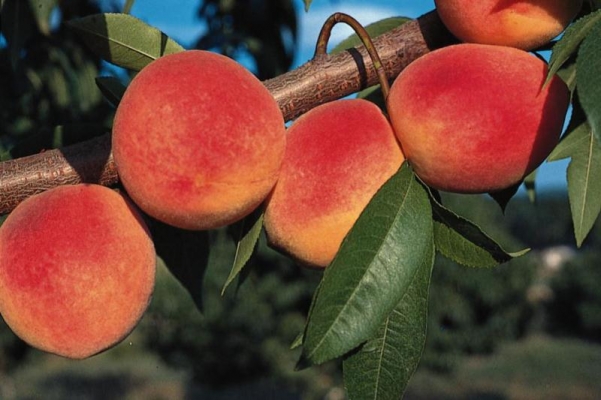Elberta: This variety is good for fresh eating and for storage purpose. It has round shape fruits and flesh is yellow in color. It has enough juice content.
Alexander: It has big sized fruits, round and deep green in color on which shiny red spots are seen. It has white-green flesh, sweet and juicy in nature.
Noblesse: It has medium sized fruits which are green in color taking yellowish color and on which red stripes are seen. Fruits have soft flesh, juicy, sweet, bound to kernel and are aromatic. The variety matures in mid-August.
Golden Bush: Fruits are small to medium in size and has thick peel and are reddish yellow in color. Fruits have golden flesh, hard, less juicy, bound with kernel, and are tasteless.
Crawford Early: Fruits are medium in shape. Fruits have yellow flesh and are bound with kernel. The variety is suitable for storage purpose.
Florida Sun: Its tree starts giving fruit in 3-4 years and the fruit matures in end-April. Fruits are medium to big in size and are round in shape. It contains 11-12.5% soild elements, 0.5-0.6% sour content and yellow flesh which is juicy. It gives an average yield of 100kg/tree.
Florida Red: An excellent, mid-season fruits, it matures in the early of June. Fruits are large, almost red at maturity, juicy, with free stone. Its average yield is 100 kg/tree.
Florida Prince: Its fruits are medium to big in size (76gm), round, light, light peak, and peel is yellow in color. Fruits have yellow color flesh, and are sticked to kernel. The variety matures in end week of April.
Florida Grande: It has big sized fruits (91.1gm). Fruits have yellow color flesh. It is good for transportation purpose. It gives an average yield of 95kg fruits per tree.
Pratap: Fruits are medium to large in size (66gm). Its flesh is firm and yellow-red in color. The fruits mature in third week of April. It gives an average yield of 70kg fruits per tree.
Shan-E- Punjab: It ripens in the 2nd week of May. Fresh fruits are quite big, yellow-colored with radish blush, superb in flavour, as well as free stone. As fruit are rigid in quality, it is good for transportation purpose. They are suited to canning; the regular fruit yield is 125kg/tree.
Saharanpur Prabhat: The variety matures in end week of April. Fruits are medium in shape. Fruit flesh is sweet, white, bound to kernel and are flavored. The fruit contains 12.5% total soluble elements, 0.37% sour element, 6.2% sugar content and 12mg vitamin C per 100gm fruit.











